
Quick Tips
- Gathering your cleaning supplies.
- Prepare the area to be cleaned.
- Prepare your cleaning solution.
- Washing the kitchen grease.
- Use the vinegar water to rinse off the soap.
- Dump the vinegar water and do a final rinse.
- Dry the surface thoroughly.
If you cook like me, every nook and cranny of the kitchen ends up a greasy mess. While I do my best to wash the surfaces and make the kitchen “look” clean, some of that sneaky grease splatter may get overlooked. You know the grease culprits: the cracks between the stove and the framing, the side of the microwave, the surrounding cabinet doors, and the underside of the vent hood. Oh, did I forget the walls behind the stove? Gross. Many of us don’t have the time to wash everywhere every time we cook so grease has the chance to become dried and built-up.
There are all kinds of products out there to clean grease, but I wouldn’t bother with most of them. You probably already have products in your cabinet that will effectively dissolve the oil and break through the dried grease from your kitchen surfaces and appliances. In the following sections, I will outline some simple steps to green clean kitchen grease and make your kitchen healthier and sparkling. The steps can be used safely on most kitchen surfaces, but I would always test a small area first if you are unsure about the effects (especially with natural stone surfaces).
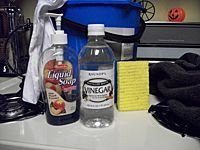 Gathering your cleaning supplies. You are going to want to follow these steps one after another, so it helps to speed up the process if you gather your supplies before you start. You will need a small bucket (a larger bowl will work fine, too). Then find a mid- to large-sized bucket, a sponge, some microfiber cloths or regular cleaning rags, and a towel. If your whole kitchen is a mess, grab a few towels. Your cleaning products for this greasy job are mild dish soap and some white vinegar. Yes, soap and vinegar. You do not need any expensive, toxic, eye-burning cleaner to cut through dried-on grease.
Gathering your cleaning supplies. You are going to want to follow these steps one after another, so it helps to speed up the process if you gather your supplies before you start. You will need a small bucket (a larger bowl will work fine, too). Then find a mid- to large-sized bucket, a sponge, some microfiber cloths or regular cleaning rags, and a towel. If your whole kitchen is a mess, grab a few towels. Your cleaning products for this greasy job are mild dish soap and some white vinegar. Yes, soap and vinegar. You do not need any expensive, toxic, eye-burning cleaner to cut through dried-on grease. Prepare the area to be cleaned. So you’re done cooking. Take the time to put away the food before trying to wipe up the grease splatter. Remove the burner plates from the stove and clean them with your dishes. For countertops, move small appliances to another location to allow for easy access. If your cabinets need to be wiped down too, remove the hardware and soak them in a sink with soapy water. Place towels on the floor under the cabinets to catch any dripping water from the cleaning process. Also, take note of what areas seem to be really disgusting—it is good info for future maintenance.
Prepare the area to be cleaned. So you’re done cooking. Take the time to put away the food before trying to wipe up the grease splatter. Remove the burner plates from the stove and clean them with your dishes. For countertops, move small appliances to another location to allow for easy access. If your cabinets need to be wiped down too, remove the hardware and soak them in a sink with soapy water. Place towels on the floor under the cabinets to catch any dripping water from the cleaning process. Also, take note of what areas seem to be really disgusting—it is good info for future maintenance.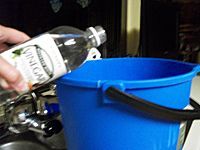 Prepare your cleaning solution. Get out your small bucket and fill it with a couple pints of hot water. Add two tablespoons of dish soap and give it a good stir. Place the sponge in the mixture. Now let’s turn to the vinegar: In your larger bucket, mix one cup of white vinegar to one to one and a half gallons of warm water. I know vinegar smells a bit and you’re asking yourself why you would want to wipe your kitchen with that smelly stuff, but the odor will dissipate and the vinegar is great for cleaning grease from most kitchen surfaces.
Prepare your cleaning solution. Get out your small bucket and fill it with a couple pints of hot water. Add two tablespoons of dish soap and give it a good stir. Place the sponge in the mixture. Now let’s turn to the vinegar: In your larger bucket, mix one cup of white vinegar to one to one and a half gallons of warm water. I know vinegar smells a bit and you’re asking yourself why you would want to wipe your kitchen with that smelly stuff, but the odor will dissipate and the vinegar is great for cleaning grease from most kitchen surfaces.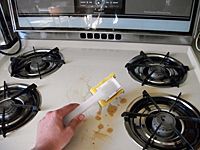 Washing the kitchen grease. Remove the sponge from the soapy water and ring it out a little bit. For really tough dried-on grease, add a little more soap directly to the sponge. Work the soap into a lather and apply it to the area to be cleaned. Allow the soap to sit on the grease for a couple of minutes. Rub in a circular motion until it appears that the grease has been loosened. This step may take a little muscle for certain jobs, but the dish soap should suffice in dissolving the oil.
Washing the kitchen grease. Remove the sponge from the soapy water and ring it out a little bit. For really tough dried-on grease, add a little more soap directly to the sponge. Work the soap into a lather and apply it to the area to be cleaned. Allow the soap to sit on the grease for a couple of minutes. Rub in a circular motion until it appears that the grease has been loosened. This step may take a little muscle for certain jobs, but the dish soap should suffice in dissolving the oil.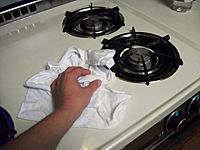 Use the vinegar water to rinse off the soap. Take a rag or a microfiber cloth (my personal preference) and dip it into the vinegar water. With the wet rag, rinse away the soap from the surface. Dip the rag in the vinegar water as needed to rinse the rag and continue until all the soap has been removed. With larger areas, you may need to change rags from time to time to ensure that you are not spreading grease from one area to another. Be liberal in rag rinses and changes or you could end up with a bigger grease mess than you started with.
Use the vinegar water to rinse off the soap. Take a rag or a microfiber cloth (my personal preference) and dip it into the vinegar water. With the wet rag, rinse away the soap from the surface. Dip the rag in the vinegar water as needed to rinse the rag and continue until all the soap has been removed. With larger areas, you may need to change rags from time to time to ensure that you are not spreading grease from one area to another. Be liberal in rag rinses and changes or you could end up with a bigger grease mess than you started with.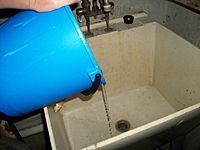 Dump the vinegar water and do a final rinse. Dump the dirty vinegar water down a drain. I would use your laundry sink as you do not want grease on surfaces like your shower floor. No one likes ice skating while showering. Rinse the bucket and refill with plain warm water. Grab a clean cloth and rinse off the kitchen surface one more time to ensure that both the soap and vinegar have been removed. Soap residue can dull a kitchen surface in the same way grease buildup can. Any remaining residue will attract more dirt.
Dump the vinegar water and do a final rinse. Dump the dirty vinegar water down a drain. I would use your laundry sink as you do not want grease on surfaces like your shower floor. No one likes ice skating while showering. Rinse the bucket and refill with plain warm water. Grab a clean cloth and rinse off the kitchen surface one more time to ensure that both the soap and vinegar have been removed. Soap residue can dull a kitchen surface in the same way grease buildup can. Any remaining residue will attract more dirt.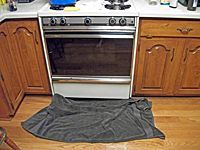 Dry the surface thoroughly. Take a clean towel and dry the area. Try to soak up as much moisture as you can, paying attention to the crevices where soapy grease could be hiding. Use the towel to shine the surface. If you had placed towels on the ground, pick them up and be very careful to remove spilled water from the floor. You don’t want people coming into the kitchen to admire how clean it is and fall on their heads. That would be bad. And possibly expensive.
Dry the surface thoroughly. Take a clean towel and dry the area. Try to soak up as much moisture as you can, paying attention to the crevices where soapy grease could be hiding. Use the towel to shine the surface. If you had placed towels on the ground, pick them up and be very careful to remove spilled water from the floor. You don’t want people coming into the kitchen to admire how clean it is and fall on their heads. That would be bad. And possibly expensive.
Other Natural Products that Double as Degreasers
If you’re sitting in your kitchen thinking, I only have dishwasher detergent and I don’t think I have ever used white vinegar in my life, you may have other options in your home. Take a look around and see if you have any baking soda. Instead of using the dish soap, you could mix a few tablespoons of baking soda with about twelve ounces of warm water. Use this mixture with the sponge to work on the grease. Baking soda is great as a degreaser to tackle dried oil splatter from most kitchen appliances and countertops.
If you don’t have any baking soda either then see if you have any orange cleaner around. Orange cleaner is effective in cutting through grease, but be careful as it may not be safe for all surfaces. No orange cleaner? Lemon can be used as a degreaser. Cut the lemon in half and rub it over the dried oil. However, much like the orange cleaner, it is a citric acid that may not be appropriate for some materials that are susceptible to etching by acidic substances (like natural stone). Now, if you are aggravated because you don’t have any of these items then you may need to take a trip to the store. Sorry. It’s all I got for you.
Green Products for Cleaning Kitchen Grease
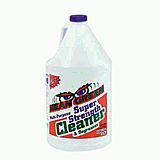 Mean Green Cleaner & Degreaser is a unique blend of nontoxic, biodegradable detergents designed to be gentle enough for everyday cleaning projects including upholstery and carpets, but strong enough for cutting through extreme dirt and grime, even on engines. This powerful, extra heavy-duty cleaner and degreaser can be used if you have a large, extra-tough kitchen grease problem. While environmentally safe and user-friendly, this degreaser is also pretty affordable for an industrial-strength product. You can order bottles of Mean Green from Amazon.
Mean Green Cleaner & Degreaser is a unique blend of nontoxic, biodegradable detergents designed to be gentle enough for everyday cleaning projects including upholstery and carpets, but strong enough for cutting through extreme dirt and grime, even on engines. This powerful, extra heavy-duty cleaner and degreaser can be used if you have a large, extra-tough kitchen grease problem. While environmentally safe and user-friendly, this degreaser is also pretty affordable for an industrial-strength product. You can order bottles of Mean Green from Amazon.
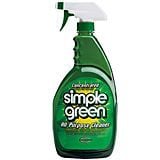 Simple Green All-Purpose Cleaner is a nontoxic, environmentally friendly cleaner and degreaser that can be diluted for a wide range of applications around the house. Simple Green is safe for sinks, drains, pots and pans, floors, walls, and greasy appliances. This extremely versatile cleaner can replace many of your other household cleaners and detergents. Simple Green All-Purpose Cleaner can be used on most washable surfaces. It removes the toughest stains including dirt, grease, and oil.
Simple Green All-Purpose Cleaner is a nontoxic, environmentally friendly cleaner and degreaser that can be diluted for a wide range of applications around the house. Simple Green is safe for sinks, drains, pots and pans, floors, walls, and greasy appliances. This extremely versatile cleaner can replace many of your other household cleaners and detergents. Simple Green All-Purpose Cleaner can be used on most washable surfaces. It removes the toughest stains including dirt, grease, and oil.
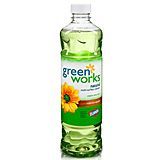 Green Works Multi-Surface Cleaner is a naturally derived product made from plant- and mineral-based ingredients, but is strong enough to cut through dirt, grime, and dried-on oil and grease. Despite having the cleaning power of a product like bleach, this cleaner is safe for most surfaces. Green Works can help you tackle the toughest kitchen grease while being a safe option for your family and home.
Green Works Multi-Surface Cleaner is a naturally derived product made from plant- and mineral-based ingredients, but is strong enough to cut through dirt, grime, and dried-on oil and grease. Despite having the cleaning power of a product like bleach, this cleaner is safe for most surfaces. Green Works can help you tackle the toughest kitchen grease while being a safe option for your family and home.